|
 Jump to: Barry Friedman Gallery Jump to: Barry Friedman Gallery
Jump to: Dai Ichi Arts Gallery
Interest in Japanese pottery is alive and doing fairly well in New York City. I had the pleasure to spend a week there in mid March and saw some nice pots. What also was a pleasant surprise was to hear the many comments from those very much interested in the contemporary ceramic scene in Japan.
After my presentation (March 2001) at NYU on the subject, quite a few people approached me with praise, asking about how to find more on the topic of Japanese pottery. Of course I directed them to this web site! I also told them about two places in New York where one can see some good work. One is a special exhibition of five Kyoto potters at the Barry Friedman Ltd. Gallery and the other is the only gallery in town with a permanent display, Dai Ichi Arts.
Masters of Clay
Five Artists from Kyoto Exhibition
Showing Until April 28, 2001
Barry Friedman Ltd. Gallery
32 East 67th St. New York City
TEL: 212-794-8950
Joan Mirviss, who arranged this exhibition, shows other work by appointment only. She can be contacted at 212-721-5148
The BF Exhibition is very significant, for it raises the stature of contemporary Japanese pottery by having it shown in such a splendidly fine gallery. The five artists from Kyoto (Suzuki Osamu, Morino Hiroaki Taimei, Miyashita Zenji, Kishi Eiko, and Kondo Takahiro) all presented first-rate work that was a good match for the fine-arts exhibition space. In fact, it's the first time for the BF Gallery to exhibit contemporary Japanese pottery. The whole exhibition was actually arranged by Joan Mirviss of Joan B Mirviss Ltd., and she went to each artists' home in Kyoto to pick the best works.
It was a good thing she did for Miyashita's work can be uneven and it's really a far larger gamble if the work isn't selected by the producer. Mirviss has a fantastic eye and suitably choose work to match the three-room setting.
As one walks into the wonderful townhouse and up the spiral staircase to the third floor, a feeling of entering into a special place is felt. There are no doors to open as one walks in the BF Gallery, just rooms to explore, and one becomes bedazzled by what a great place it is. The first dark room on the left is filled the works of Kishi and Kondo.
Kishi is the only feamle potter in the group and is showing her Saiseki-zogan works. Incredibly delicate patterns appear as almost stitched into the clay. The forms range from large geometric walls to smaller oval-and-hexagonal-covered vessels.
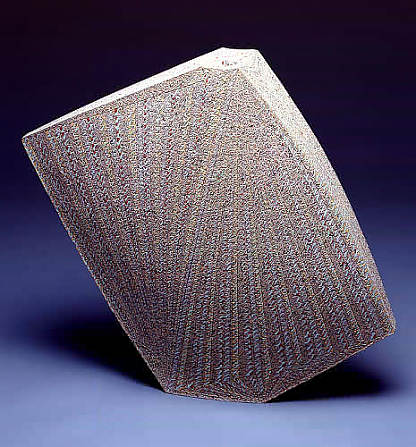 |
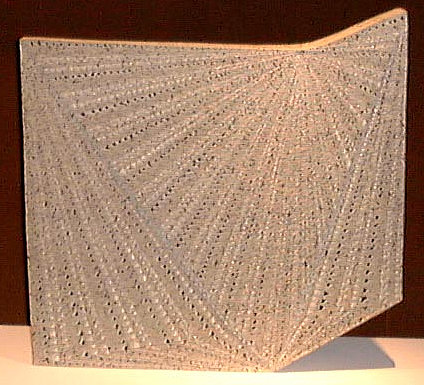 |
 |
Kishi's saiseki-zogan process involves mixing colored pigments into the Shigaraki clay and then forming it into her desired shape. Then a design is etched out with a very hard needle and pigments, and clay or glazes are then applied again. The results are outstanding with yellows, reds, greens, blues and whites weaving around the works in fanciful colored bands.
Kondo Takahiro's work deals with the color blue. He's following in the footsteps of his Living National Treasure (LNT) grandfather Kondo Yuzo who was named a LNT for his work in sometsuke or cobalt blue. Yet this Kondo is far from just imitating grandpa, he's created his own technique that has the works coming out of the kiln looking wet! The 'rain frozen through fire' effect is droplets of pure silver that Kondo applies before firing. A few pieces had a deep indigo blue color with these silver beads studded on the surface - quite spectacular stuff.
Other Kondo pieces were larger slender forms with stripes.
LEARN MORE ABOUT KONDO TAKAHIRO
Exhibition 2005 (Includes 40 photos)
Exhibition 2001 in Japan
Konda Takahiro periodically holds exhibitions
of his work at Yufuku Gallery in Tokyo.
Click here for Yufuku details & photos.
Around the corner on the left is a completely different room with a brighter ambience that aptly suited the pastel colored works of Miyashita Zenji and the rusty red forms of Suzuki Osamu.
Miyashita's work features overlapping bands of colors. Indeed, a rainbow of colors, with his purples and pinks being especially pleasing. One large triangular piece with a brilliant display of color had an abrupt contrast over the side in diagonal stripes of silver and black; a stunning piece.
Other works were in curvy torso forms, angled vases, and circular rings. As with all the rooms, BF's staff selected excellent furniture and settings for each artist.
Suzuki's work stood in somber contrast to Miyashita's but was not in the least out of place. In a way they complimented each other with the showy and the subdued. Suzuki is a major figure in 20th-century Japanese art, having formed the influential avant-garde ceramic group Sodeisha along with Yagi Kazuo and Yamada Hikaru in post-WWll Japan. His forms are organic, and the monochrome tone of each piece allows the viewer to focus on the form; always with a slightly rough surface, rounded with edgy borders.
The final room to the right of the stairwell is filled with Morino's work. Morino's work hasn't really changed that much over the decades, box forms with linear patterns or L-shaped characters bouncing over the surface like a Keith Harring dance. Others have tooth-like appendages angled out the sides, usually two on one side and one on the other.
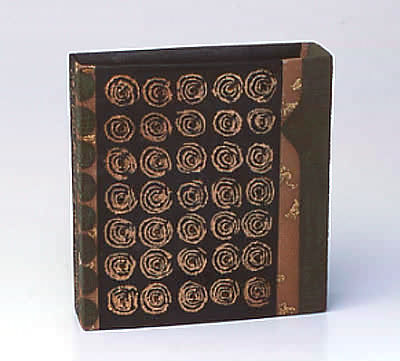 |
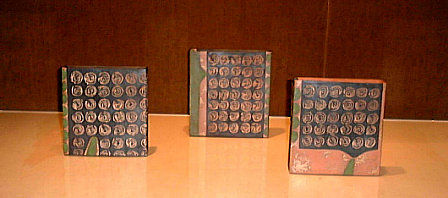 |
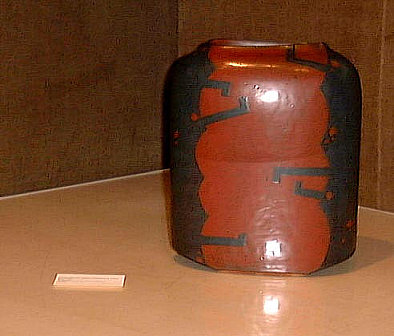 |
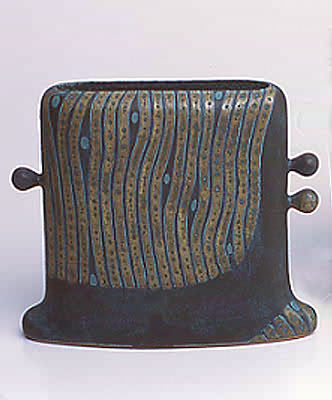 |
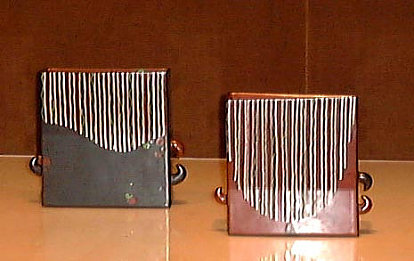 |
This gallery, and others, usually don't do this type of exhibition -- bring what some see as crafts into the hallowed fine-arts space. A triumph for Joan Mirviss and a compliment to Barry Friedman for his willingness to take a chance and also for his fine taste in doing so. Many people thought so too for the opening was very well attended.
Dai Ichi Arts
Gallery Building, 24 West 57th Ave.
TEL: 212-262-0239
Dai Ichi Arts is just celebrating its ten-year anniversary now with a retrospective look at some of the more popular potters it carries. The gallery lacks the atmosphere of BF, yet has a dozen or so potters that it routinely handles and can be viewed at any time. The gallery consists of two rooms on the sixth floor of the Gallery Building at 24 West 57th Ave.
Director Beatrice Chang tries to select the best work she can and most of the time it's quite good. I saw some nice pieces by Bizen's Abe Anjin, Iga by Tsujimura Shiro, and Shigaraki's Kohyama Yasuhisa among others (one photo each below, in same order).
 |
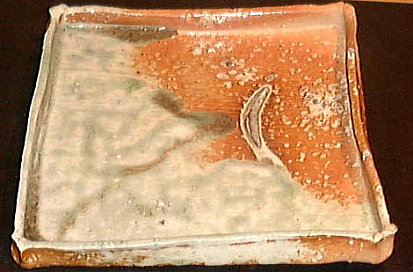 |
 |
The only problem I thought was the smattering of American potters trying to be Japanese, but I guess they help bring in the locals and that's good for business.
Congratulations goes to Dai Ichi for making it for a decade in the difficult art world of New York. A toast to another ten!
by Robert Yellin
|